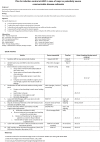Ebola outbreak response; experience and development of screening tools for viral haemorrhagic fever (VHF) in a HIV center of excellence near to VHF epicentres
- PMID: 25007269
- PMCID: PMC4090118
- DOI: 10.1371/journal.pone.0100333
Ebola outbreak response; experience and development of screening tools for viral haemorrhagic fever (VHF) in a HIV center of excellence near to VHF epicentres
Abstract
Introduction: There have been 3 outbreaks of viral hemorrhagic fever (VHF) in Uganda in the last 2 years. VHF often starts with non-specific symptoms prior to the onset of haemorrhagic signs. HIV clinics in VHF outbreak countries such as Uganda see large numbers of patients with HIV 1/2 infection presenting with non-specific symptoms every day. Whilst there are good screening tools for general health care facilities expecting VHF suspects, we were unable to find tools for use in HIV or other non-acute clinics.
Methods: We designed tools to help with communication to staff, infection control and screening of HIV patients with non-specific symptoms in a large HIV clinic during the outbreaks in Uganda. We describe our experiences in using these tools in 2 Ebola Virus Disease outbreaks in Uganda.
Results: During the Ebola Virus Disease (EVD) outbreaks, enhanced infection control and communication procedures were implemented within 24 hours of the WHO/Ministry of Health announcement of the outbreaks. During course of these outbreaks the clinic saw 12,544 patients with HIV 1/2 infection, of whom 3,713 attended without an appointment, suggesting new symptoms. Of these 4 were considered at risk of EVD and seen with full infection procedures; 3 were sent home after further investigation. One patient was referred to the National Referral Hospital VHF unit, but discharged on the same day. One additional VHF suspect was identified outside of a VHF outbreak; he was transferred to the National Referral Hospital and placed in isolation within 2 hours of arriving at the HIV clinic.
Discussion: Use of simple screening tools can be helpful in managing large numbers of symptomatic patients attending for routine and non-routine medical care (including HIV care) within a country experiencing a VHF outbreak, and can raise medical staff awareness of VHF outside of the epidemics.
Conflict of interest statement
Figures
Similar articles
-
Period prevalence and identification challenges of viral haemorrhagic fever suspect cases in a tertiary referral hospital in Guinea: a cross-sectional, retrospective study of triage and emergency room patient profiles.BMC Infect Dis. 2020 Nov 12;20(1):838. doi: 10.1186/s12879-020-05573-8. BMC Infect Dis. 2020. PMID: 33183252 Free PMC article.
-
Rapid establishment of a frontline field laboratory in response to an imported outbreak of Ebola virus disease in western Uganda, June 2019.PLoS Negl Trop Dis. 2021 Dec 3;15(12):e0009967. doi: 10.1371/journal.pntd.0009967. eCollection 2021 Dec. PLoS Negl Trop Dis. 2021. PMID: 34860831 Free PMC article.
-
Understanding the delay in identifying Sudan Virus Disease: gaps in integrated disease surveillance and response and community-based surveillance to detect viral hemorrhagic fever outbreaks in Uganda, September 2022.BMC Infect Dis. 2024 Jul 30;24(1):754. doi: 10.1186/s12879-024-09659-5. BMC Infect Dis. 2024. PMID: 39080599 Free PMC article.
-
The number of cases, mortality and treatments of viral hemorrhagic fevers: A systematic review.PLoS Negl Trop Dis. 2022 Oct 31;16(10):e0010889. doi: 10.1371/journal.pntd.0010889. eCollection 2022 Oct. PLoS Negl Trop Dis. 2022. PMID: 36315609 Free PMC article.
-
Treatment of ebola virus disease.Pharmacotherapy. 2015 Jan;35(1):43-53. doi: 10.1002/phar.1545. Pharmacotherapy. 2015. PMID: 25630412 Review.
Cited by
-
The effect of Ebola Virus Disease outbreak on hand washing among secondary school students in Ondo State Nigeria, October, 2014.Pan Afr Med J. 2015 Oct 11;22 Suppl 1(Suppl 1):24. doi: 10.11694/pamj.supp.2015.22.1.6614. eCollection 2015. Pan Afr Med J. 2015. PMID: 26740852 Free PMC article.
-
Ebola in West Africa: be aware and prepare.Intensive Care Med. 2014 Nov;40(11):1742-5. doi: 10.1007/s00134-014-3497-z. Epub 2014 Sep 25. Intensive Care Med. 2014. PMID: 25253023 Review. No abstract available.
-
Rapid Decision Algorithm for Patient Triage during Ebola Outbreaks.Emerg Infect Dis. 2024 Nov;30(11):1-11. doi: 10.3201/eid3011.231650. Emerg Infect Dis. 2024. PMID: 39447210 Free PMC article.
-
Viral Hemorrhagic Fever Diagnostics.Clin Infect Dis. 2016 Jan 15;62(2):214-9. doi: 10.1093/cid/civ792. Epub 2015 Sep 9. Clin Infect Dis. 2016. PMID: 26354968 Free PMC article. Review.
-
Are surveillance response systems enough to effectively combat and contain the Ebola outbreak?Infect Dis Poverty. 2015 Jan 9;4(1):7. doi: 10.1186/2049-9957-4-7. eCollection 2015. Infect Dis Poverty. 2015. PMID: 25671127 Free PMC article.
References
-
- Centers for Disease C Viral hemorrhagic fevers. Available: http://wwwcdcgov/ncidod/dvrd/spb/mnpages/dispages/vhfhtm:.
-
- WHO Hemorrhagic Fevers, Viral.Available: http://wwwwhoint/topics/haemorrhagic_fevers_viral/en/.
-
- Locsin RC, Matua AG (2002) The lived experience of waiting-to-know: Ebola at Mbarara, Uganda—hoping for life, anticipating death. J Adv Nurs 37: 173–181. - PubMed
MeSH terms
LinkOut - more resources
Full Text Sources
Other Literature Sources
Medical





